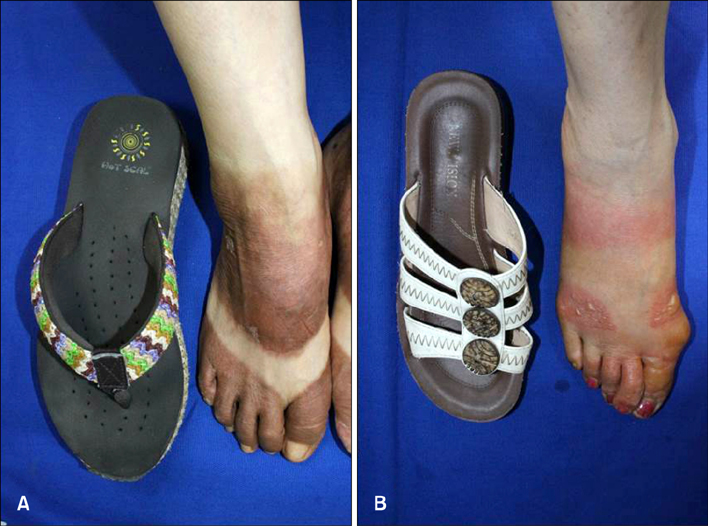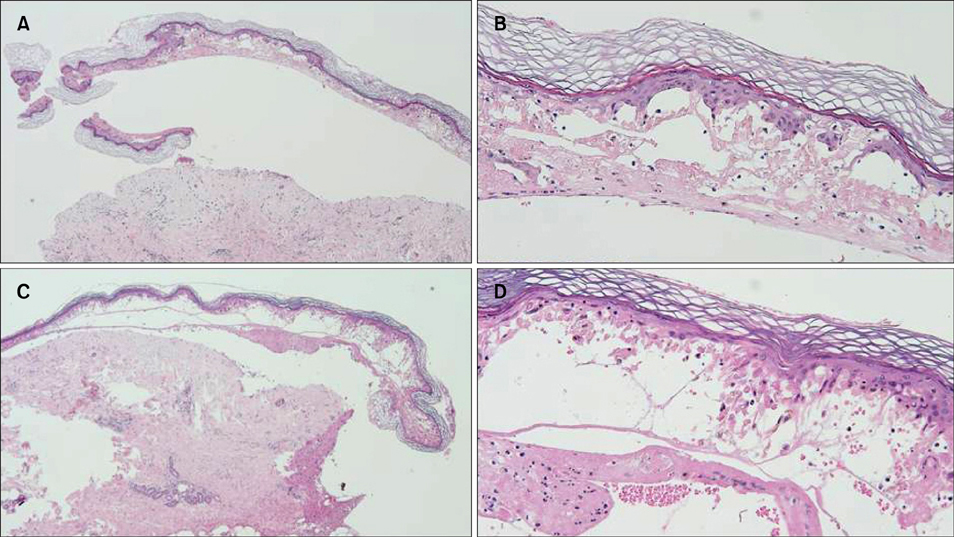Ann Dermatol.
2017 Feb;29(1):86-90. 10.5021/ad.2017.29.1.86.
Five Cases of Phytophotodermatitis Caused by Fig Leaves and Relevant Literature Review
- Affiliations
-
- 1Department of Dermatology, School of Medicine, Pusan National University, Busan, Korea. dockbs@pusan.ac.kr
- 2Biomedical Research Institute, Pusan National University Hospital, Busan, Korea.
- KMID: 2368034
- DOI: http://doi.org/10.5021/ad.2017.29.1.86
Abstract
- Phytophotodermatitis is a condition caused by sequential exposure to photosensitizing substances present in plants followed by ultraviolet light. Several plants (e.g., limes, celery, fig, and wild parsnip) contain furocoumarin compounds (psoralens). It is important for dermatologists to be aware of phytophotodermatitis because it may be misdiagnosed as cellulitis, tinea, or allergic contact dermatitis. We present five patients with a sharply defined erythematous swollen patch with bullae on both feet. They described soaking their feet in a fig leaves decoction to treat their underlying dermatologic diseases. Within 24 hours, all patients had a burning sensation in their feet, and erythema and edema had developed on the feet dorsa with exception of the portion of the skin covered by the sandals. Histopathologic examinations revealed sub-epithelial blisters with intensive epidermal necrosis. Phytophotodermatitis was ultimately diagnosed and, after several days, the patients' skin lesions began to recover upon treatment with systemic and topical corticosteroids. Unfortunately, since there are no studies providing sufficient evidence on the benefits of fig leaves, they should be used with caution.
Keyword
MeSH Terms
Figure
Reference
-
1. Karimian-Teherani D, Kinaciyan T, Tanew A. Photoallergic contact dermatitis to Heracleum giganteum. Photodermatol Photoimmunol Photomed. 2008; 24:99–101.
Article2. Bonamonte D, Foti C, Lionetti N, Rigano L, Angelini G. Photoallergic contact dermatitis to 8-methoxypsoralen in Ficus carica. Contact Dermatitis. 2010; 62:343–348.
Article3. Maverakis E, Miyamura Y, Bowen MP, Correa G, Ono Y, Goodarzi H. Light, including ultraviolet. J Autoimmun. 2010; 34:J247–J257.
Article4. Ena P, Cerri R, Dessi G, Manconi PM, Atzei AD. Phototoxicity due to Cachrys libanotis. Contact Dermatitis. 1991; 24:1–5.5. Zaynoun ST, Aftimos BG, Abi Ali L, Tenekjian KK, Khalidi U, Kurban AK. Ficus carica; isolation and quantification of the photoactive components. Contact Dermatitis. 1984; 11:21–25.
Article6. Neumann NJ, Lehmann P. The photopatch test procedure of the German, Austrian, and Swiss photopatch test group. Photodermatol Photoimmunol Photomed. 2003; 19:8–10.
Article7. Kim T. Classical texts in the present tense: the looking diagnosis of a Donguibogam school in South Korea. J Altern Complement Med. 2014; 20:300–304.
Article8. Goitre M, Bedello PG, Cane D, Alovisi V. Phytophotodermatitis caused by fig tree. G Ital Dermatol Venereol. 1984; 119:435–436.9. Lembo G, Lo Presti M, Balato N. Phytophotodermatitis due to ficus carica. Photodermatol. 1985; 2:119–120.10. Lee CB, Han EN, Kim NI, Haw CR. Phytophotodermatitis. Korean J Dermatol. 1986; 24:278–282.11. Watemberg N, Urkin Y, Witztum A. Phytophotodermatitis due to figs. Cutis. 1991; 48:151–152.12. Bollero D, Stella M, Rivolin A, Cassano P, Risso D, Vanzetti M. Fig leaf tanning lotion and sun-related burns: case reports. Burns. 2001; 27:777–779.
Article13. Ozdamar E, Ozbek S, Akin S. An unusual cause of burn injury: fig leaf decoction used as a remedy for a dermatitis of unknown etiology. J Burn Care Rehabil. 2003; 24:229–233.
Article14. Bassioukas K, Stergiopoulou C, Hatzis J. Erythrodermic phytophotodermatitis after application of aqueous fig-leaf extract as an artificial suntan promoter and sunbathing. Contact Dermatitis. 2004; 51:94–95.
Article15. Derraik JG, Rademaker M. Phytophotodermatitis caused by contact with a fig tree (Ficus carica). N Z Med J. 2007; 120:U2658.16. Polat M, Oztas P, Dikilitas MC, Alli N. Phytophotodermatitis due to Ficus carica. Dermatol Online J. 2008; 14:9.17. Abali AE, Aka M, Aydogan C, Haberal M. Burns or phytophotodermatitis, abuse or neglect: confusing aspects of skin lesions caused by the superstitious use of fig leaves. J Burn Care Res. 2012; 33:e309–e312.18. Moreau JF, English JC 3rd, Gehris RP. Phytophotodermatitis. J Pediatr Adolesc Gynecol. 2014; 27:93–94.
Article
- Full Text Links
- Actions
-
Cited
- CITED
-
- Close
- Share
- Similar articles
-
- Phytophotodermatitis
- Phytophotodermatitis due to a Citrus-Based Hand Sanitizer: A Case Report
- Asymptomatic Hyperpigmentation without Preceding Inflammation as a Clinical Feature of Citrus Fruits-Induced Phytophotodermatitis
- Erratum: Coronary Stent on Coronary CT Angiography: Assessment with Model-Based Iterative Reconstruction Technique
- Erratum to “Stimulating Effect of a Novel Synthesized Sulfonamido-Based Gallate ZXHA-TC on Primary Osteoblasts†by Jin P, et al. (Yonsei Med J 2015;56(3):760-771.)




